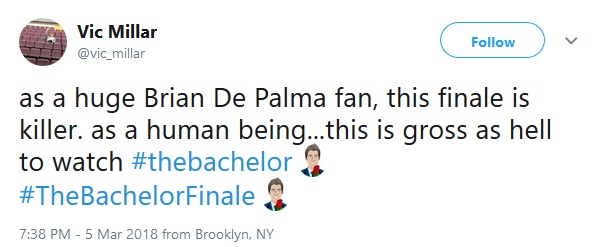

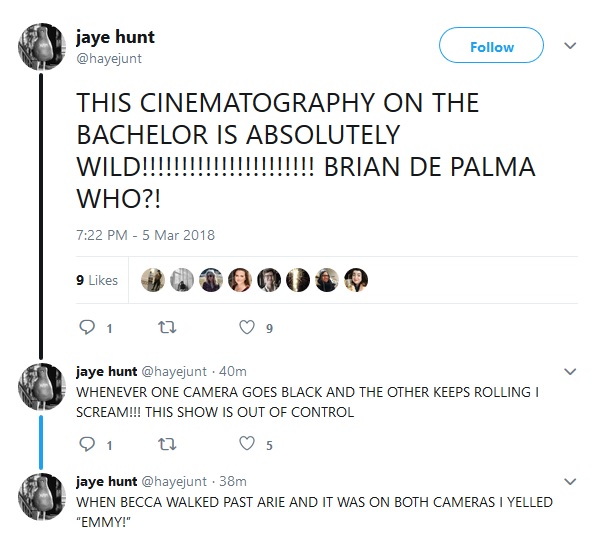

Updated: Tuesday, March 6, 2018 8:10 PM CST
Post Comment | Permalink | Share This Post
 Hello and welcome to the unofficial Brian De Palma website. Here is the latest news: |
|---|
E-mail
Geoffsongs@aol.com
-------------
Recent Headlines
a la Mod:
Listen to
Donaggio's full score
for Domino online
De Palma/Lehman
rapport at work
in Snakes
De Palma/Lehman
next novel is Terry
De Palma developing
Catch And Kill,
"a horror movie
based on real things
that have happened
in the news"
Supercut video
of De Palma's films
edited by Carl Rodrigue
Washington Post
review of Keesey book
-------------
Exclusive Passion
Interviews:
Brian De Palma
Karoline Herfurth
Leila Rozario
------------
------------
| « | March 2018 | » | ||||
| S | M | T | W | T | F | S |
| 1 | 2 | 3 | ||||
| 4 | 5 | 6 | 7 | 8 | 9 | 10 |
| 11 | 12 | 13 | 14 | 15 | 16 | 17 |
| 18 | 19 | 20 | 21 | 22 | 23 | 24 |
| 25 | 26 | 27 | 28 | 29 | 30 | 31 |
De Palma interviewed
in Paris 2002
De Palma discusses
The Black Dahlia 2006

Enthusiasms...
Alfred Hitchcock
The Master Of Suspense
Sergio Leone
and the Infield
Fly Rule
The Filmmaker Who
Came In From The Cold
Jim Emerson on
Greetings & Hi, Mom!
Scarface: Make Way
For The Bad Guy
Deborah Shelton
Official Web Site
Welcome to the
Offices of Death Records




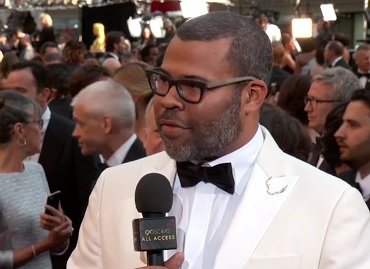 Jordan Peele was interviewed on ABC-TV's live pre-Oscar red carpet show tonight, where the hosts asked him about his inspirations for Get Out. Peele responded by echoing what he said on stage yesterday when Spike Lee presented him with the best director award at the Film Independent Spirit Awards. "Getting this award from Spike is crazy — let's make no mistake, I would not be standing here if it wasn't for this man," Peele said as he looked back toward Lee, who had mentioned that Get Out is a "masterpiece." Tonight on the red carpet, after talking about Lee, Peele added a few more directors' names as inspirations for Get Out: Steven Spielberg, John Carpenter, Stanley Kubrick, and Brian De Palma.
Jordan Peele was interviewed on ABC-TV's live pre-Oscar red carpet show tonight, where the hosts asked him about his inspirations for Get Out. Peele responded by echoing what he said on stage yesterday when Spike Lee presented him with the best director award at the Film Independent Spirit Awards. "Getting this award from Spike is crazy — let's make no mistake, I would not be standing here if it wasn't for this man," Peele said as he looked back toward Lee, who had mentioned that Get Out is a "masterpiece." Tonight on the red carpet, after talking about Lee, Peele added a few more directors' names as inspirations for Get Out: Steven Spielberg, John Carpenter, Stanley Kubrick, and Brian De Palma.
Previously:
Jordan Peele: “I want to do what Hitchcock did, what Spielberg did, what Brian De Palma did — dark tales.”

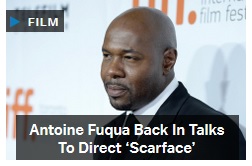 Deadline's Mike Fleming Jr reported last night that Antoine Fuqua is now back in talks to direct Universal's planned remake of Scarface. The film, previously slated for release on August 10, 2018, stalled last summer when David Ayer exited the project. Fleming states that "the most recent script is by David Ayer, Jonathan Herman and Joel and Ethan Coen." Fleming also reports that Diego Luna is now uncertain to star in the picture due to potential scheduling conflicts with the changing production timeline. In his article, Fleming talks up Fuqua as director of this new version:
Deadline's Mike Fleming Jr reported last night that Antoine Fuqua is now back in talks to direct Universal's planned remake of Scarface. The film, previously slated for release on August 10, 2018, stalled last summer when David Ayer exited the project. Fleming states that "the most recent script is by David Ayer, Jonathan Herman and Joel and Ethan Coen." Fleming also reports that Diego Luna is now uncertain to star in the picture due to potential scheduling conflicts with the changing production timeline. In his article, Fleming talks up Fuqua as director of this new version:Looking at his films from Training Day to Equalizer and The Magnificent Seven, Fuqua seems a strong match for the visceral immigrant gangster storyline that was central to both the 1932 and 1983 film versions. The latter was directed by Brian De Palma, written by Oliver Stone and starred Al Pacino. Paul Muni starred in the earlier version.Fuqua will be ready after completing post on the Equalizer sequel with Denzel Washington. He has remained intrigued with reviving the original. In an interview with Deadline when he helmed The Magnificent Seven, Fuqua explained the appeal of the violence and excess of the criminal underworld that has informed both previous films.
“There are stories about that world that you couldn’t make up,” he said. “Pablo Escobar had animals from Africa and they still don’t know how he got them. Right now they’ve been trying to figure out how to deal with the growing population of what they call cocaine hippos. It’s crazy. Their lives are so over the top, El Chapo and the rest of those guys.
“But how do you make him the icon of icons? Because we have a high bar for movie icons with Al Pacino’s Tony Montana and Michael Corleone. I took Denzel into that world as a cop in Training Day, and that was a world that I know probably way too much about. I know where to go with this. I have met a lot of these cartel dudes and understand their mentality, and this f*cked up version of Robin Hood. I saw it with guys I grew up with. It starts with, I’ve got to do what I’ve got to do to feed my family. Then it turned into, I’ve got to do what I’ve got to do to survive. Then it turned into, I want it all. Your moral compass gets lost in the darkness and excess.”
Previously:
David Ayer drops out of Scarface remake
David Ayer in talks for Scarface remake
Coen Brothers will rewrite Scarface script
Fuqua drops out of Scarface remake; Diego Luna will play lead
Terence Winter to tackle Scarface script
The Scarface remake just got a lot less interesting
Scarface remake is Larraín's dream project
The Scarface remake just got a lot more interesting
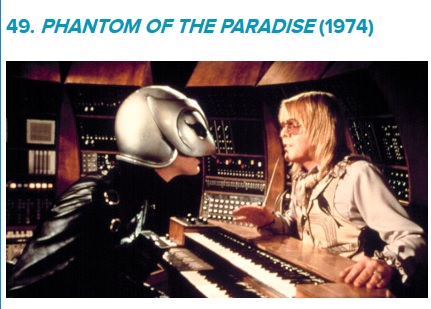 Last week, Consequence Of Sound posted its list of "The 50 Greatest Rock and Roll Movies of All Time." Phantom Of The Paradise made the list at number 49 (Edgar Wright's Baby Driver is number 50). "Phantom of the Paradise is Brian De Palma’s most whimsical and traditionally funny film," states CoS' Mike Vanderbilt in the film's entry blurb. "Good rock and roll has a sense of humor amid the cynicism and melodrama of the music. Phantom sardonically skewers the music industry, turning a record contract into a Faustian deal with the devil. Paul Williams brilliantly plays against type as the evil Swan and provides a wonderfully bizarre collection of tunes for the soundtrack, featuring faux ‘50s nostalgia with “Goodbye, Eddie, Goodbye”, the Linda Ronstadt-style country-tinged pop of “Special to Me”, the glammy “Life at Last”, and the gloriously cynical closer, “The Hell of It”.
Last week, Consequence Of Sound posted its list of "The 50 Greatest Rock and Roll Movies of All Time." Phantom Of The Paradise made the list at number 49 (Edgar Wright's Baby Driver is number 50). "Phantom of the Paradise is Brian De Palma’s most whimsical and traditionally funny film," states CoS' Mike Vanderbilt in the film's entry blurb. "Good rock and roll has a sense of humor amid the cynicism and melodrama of the music. Phantom sardonically skewers the music industry, turning a record contract into a Faustian deal with the devil. Paul Williams brilliantly plays against type as the evil Swan and provides a wonderfully bizarre collection of tunes for the soundtrack, featuring faux ‘50s nostalgia with “Goodbye, Eddie, Goodbye”, the Linda Ronstadt-style country-tinged pop of “Special to Me”, the glammy “Life at Last”, and the gloriously cynical closer, “The Hell of It”.
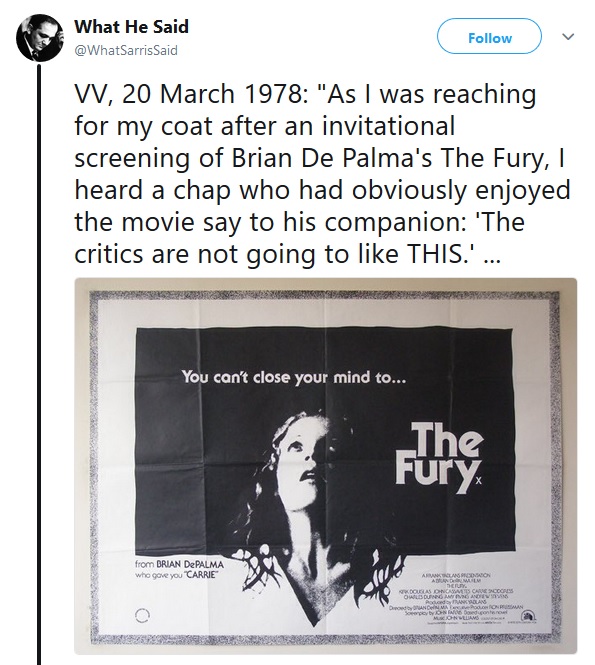
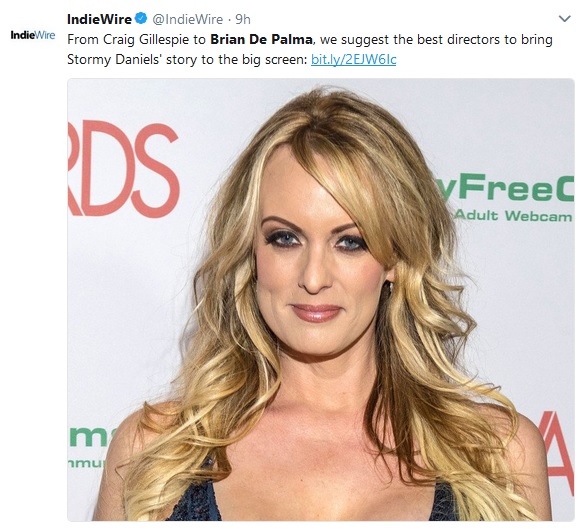
If anyone can turn the Stormy Daniels scandal into something unforgettable on the big screen, it’s got to be Brian De Palma. The director perfected the art of the erotic thriller in films such as “Body Double” and “Dressed to Kill,” and his touch of heightened sensuality would really make the story about the shady dealings between an arrogant businessman and a porn star pop. Just imagine the meeting between Daniels and Trump with De Palma’s crooked angles, sharp editing, salacious dialogue, and suggestive lighting. He’d give the story the wicked sensationalism it deserves while going for the jugular by criticizing every viewer’s fascination with it in the first place. Trump wouldn’t stand a chance against De Palma.
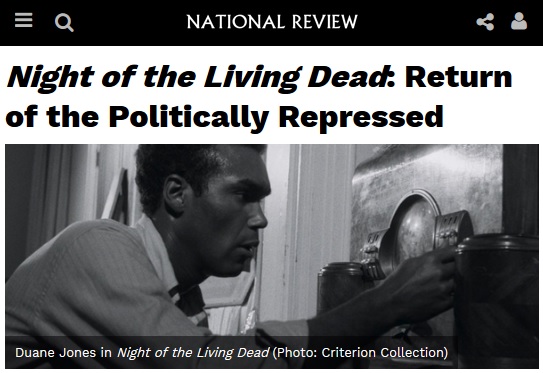
Director George Romero consciously evoked racism’s rapacity and America’s horrific history of racially motivated lynching. Although Romero’s premise (co-written with John A. Russo) inspired the zombie genre that has become newly popular this millennium (it is a contemporary symptom of our subconscious social anxiety), his film, for all that, was not ahead of its time. In other words, it did not anticipate the insipid movie Get Out, which has become a favorite totem of self-congratulatory liberals intent on defending themselves against the stigma of racism. In that useless process, they make a mess of the millennium’s racial consciousness. Romero’s conceit has been misappropriated and transformed into the paranoia of victimhood, which reverses the lessons that Night of the Living Dead taught and trivializes what makes the film still fascinating, still unnerving.Working outside the Hollywood film industry as a Pittsburgh-based veteran of industrial films, commercials, and political spots (such as for Republican John Tabor’s 1969 Pittsburgh mayoral campaign), Romero perceived the discontents that Hollywood largely ignored in ’68.
Consider that the film first appeared alongside the socially conscious Uptight (Jules Dassin’s ghetto remake of John Ford’s IRA classic The Informer) and Sidney Poitier’s pioneering romantic comedy For Love of Ivy — movies that showed Hollywood’s conscious response to America’s restless black presence. Nineteen sixty-eight was also the year of echt R&B (the alternately hopeful, despairing, and defiant “You’re All I Need to Get By On,” “I Wish It Would Rain,” “Say It Loud, I’m Black and I’m Proud”) and, ultimately, of Martin Luther King’s assassination. Although these connections in hindsight do not weigh upon Romero’s movie, the fact is that Night of the Living Dead edged beyond mainstream Hollywood liberalism; it was part of the same cultural ferment as those films and songs. It stands on its own as a surprisingly stark, unpretentious depiction of panic and compassion.
The scenes of Romero’s mobilized vigilantes hunting down zombies uncannily resemble the black-and-white TV-news footage of marauding southern whites in the civil-rights era. Romero flips our cultural perception to force a simple but disturbing point about America, then on the verge of collapse. Ben’s life is caught within the slight, slippery distance between homegrown terror and homegrown self-defense. At one point, Romero’s narrative, which already included snippets of TV and radio broadcasts, folds in on itself and becomes surreal. It climaxes with a shocking series of stills of Ben’s dead black body, being grappled by white men carrying stevedore hooks, then thrown upon a pile of corpses — a one-man holocaust montage.
This cautionary filmmaking stings, largely because it shares in the media’s modern spectacle of annihilation but lacks today’s maudlin platitudes and arrogant gloating. (Fifty years ago, cinema was at its artistic peak, producing great works of social and psychic consciousness, such as Gillo Pontecorvo’s The Battle of Algiers and Godard’s Masculin Féminin, which featured a brief reenactment of LeRoi Jones’s play Dutchman, an intelligent, provocative precursor of both Night of the Living Dead and Get Out.)
Romero’s crudely effective technique gave his topical issues the inexorable compulsion of a nightmare like Tobe Hooper’s The Texas Chainsaw Massacre (1974), another evocation of frightening, unpredictable Americana. These movies are as terrifying as they are unpretentious. I never bought the idea that they are cathartic; their shock and psychological resonance result from the demonstration that when such racial fears are raised, there’s nothing to laugh about.
*****
Not only is Get Out a poor example of the horror genre. Its generic mishap — combining fear and comedy to supposedly meaningful purpose — fumbles Romero’s (and LeRoi Jones’s) insight. Writer-director Jordan Peele reveals a lack of seriousness about both his subject and the history of politicized filmmaking. In 1970, Brian De Palma advanced from Romero and made his first great film, Hi, Mom! — a satire on activism and the media. Its climax parodied both avant-garde theater and Public Television reality, in an extended skit titled “Be Black, Baby!” that combined black racial anger, white racial fear, and the cultural establishment’s pretenses. In 1973, De Palma went further, with the horror film Sisters, another mixed-genre tour de force spotlighting an interracial liaison (Lisle Wilson and Margot Kidder) on a TV game show titled “Peeping Toms,” combining transgressive voyeurism and miscegenation.
Get Out fans probably don’t know these precedents. As victims of our disconnected culture’s amnesia and miseducation, they ignore Romero and De Palma’s once-countercultural experiments and investigations into racial anxiety, but then they fall for the mainstream media’s manipulation of social fears.